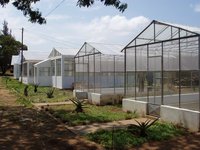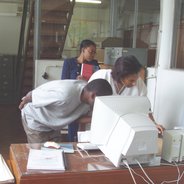Mozambique National Plant Genetic Resources Centre

Background
|

|
Mozambique NPGRC Building
|
Mozambique is on the eastern coast of Southern Africa and has a total land area of about 800 square Km comprising 10 provinces and 128 districts.
Based on rainfall temperature, altitude and evapotranspiration, the country is divided into 10 agro-climatic zones.
Mozambique has a tropical climate which is also divided into 3 major climate zones, namely: tropical humid, tropical dry and tropical climate of altitude.
The average annual temperature is around 250 Celsius and rainfall ranges from 400 to 2000 mm/year. The soil is generally of two types namely: light soils in coast zone and heavy soil in the inland.
The rainfall is reliable in the northern part of the country while it is erratic in the south. The vegetation of Mozambique belongs to the vegetation class of zambeziaca region. By and large, it comprises Miombo, Mopane, Coastal Forest and Afro-mountains system.
In Mozambique agriculture is the most important economic sector and employs most of the country.s working force. It is also the major contributor to the total gross domestic product and it comprises the following component: family and private sector.
The main food crops are maize, sorghum, groundnuts, cowpea, beans, rice, cassava and cash crops are cash nut and cotton.
National Plant Genetic Resource Programme
|

|
| Greenhouses at NPGRC |
The conservation of plant genetic diversity plays an important role in increasing the agricultural production since this effort may ensure continuous gene supply for plant breeding and crop improvement within Mozambique.
The war, drought and flood have probably contributed to the genetic erosion of crops, lose of landraces and cultural erosion. Associated with these factors there is the introduction of exotic material (modern cultivars) which resulted in replacement of the landraces, by the relief programmes.
The conservation of traditional and adapted exotic material will ensure the sustainable development of agriculture, food security and environmental stability of the country.
The main objective of PGRP is to conserve and promote sustainable use of plant genetic resources within the country, especially those which are important for agriculture and food security.
Activities
The main activities are:
- Inventory and collection of germplasm.
- Surveys of needs for germplasm re-introduction in areas which have suffered from genetic erosion
- Conservation of germplasm
- Germplasm multiplication and characterization
- Documentation.
Inventory and Collection of Germplasm
Representative seed samples of local germplasm are randomly collected from the farmers' fields. Local knowledge (description of the material according to the farmer, special traits, etc) is also recorded and documented.
The Mozambique National Plant Genetic Resources Centre (NPGRC) carried out 3 single collection missions in 2004. The collection missions were carried out in Inhambane, Nampula and Zambe.zia provinces for collecting germplasm of bambara groundnut, sorghum and pigeon pea, respectively. The collection missions were sponsored by ICRISAT-Mozambique and the last mission included the participation of staff from ICRISAT-Kenya.
A total number of 216 germplasm samples were collected during these collection missions, including 72 samples of bambara groundnut, 47samples of sorghum and 97 samples of pigeon pea. Farmers. local knowledge associated with the germplasm was also collected.
Survey of needs for germplasm re-introduction in areas which have suffered from genetic erosion
Surveys carried out by the PGRP have identified some local varieties that have been lost or are threatened with extinction due to the natural disasters.
Material
Conservation
Seed samples are maintained in deep freezers, at a temperature of - 20°C and 5% of moisture content. At present a total of 1702 accessions of cereals (58.7%), legumes (41.0%) and other cultivated plant species (0.3%) are maintained at the Mozambique NPGRC.
Multiplication
Four accessions of bambara groundnut, 80 accessions of cowpea (Vigna unguiculata) and 11 accessions of maize were multiplied at Umbeelúzi Research Station (Maputo) during the 2003/04 growing season.
Characterisation

|
| Documentation |
Characterisation is done to generate information on the morphological characteristics of each accessions.
In the 2003/04 crop season the PGRP carried out germplasm characterization of rice (39 acessions) at Chókwe Research Station (Gaza).
All accessions are documented both manually and electronically through the SPGRC Documentation and Information System (SDIS).
Organization
National Plant Genetic Resources Committee (NPGRCom)
|
Dr Paulino Munisse
|
Chairman
|
|
Ms Paciência Banze
|
Member
|
|
Mr Salomao Bandeira
|
Member
|
|
Mrs Albertina Alage
|
Member
|
|
Mrs Marina Pancas
|
Member
|
|
Mr Marcos Freire
|
Member
|
|
Mr Adolfo Bila
|
Member
|
|
Mr Pedro Víctor Rodrigues
|
Member
|
|
Mr Narciso Rodrigues
|
Member
|
|
Mr Marcela Libombo
|
Member
|
|
Mr Calisto Bias
|
Member
|
|
Mr Carlos Zandamela
|
Member
|
|
Mr António Ribeiro
|
Member
|
|
Mr David Borges
|
Member
|
|
Ms Carla do Vale
|
Member
|
|
Mr Mauricio Francisco
|
Member
|
Staff
|
Dr P. Munisse
|
Curator
|
|
Ms C. do Vale
|
Documentation & Information Officer
|
|
Mr M. Francisco
|
Characterisation & Multiplication Officer
|
|
Mr F. Reis
|
Laboratory Technician
|
|
Ms D. Magalhâes
|
Field Technician
|
Contacts
Instituto Nacional de Investigacao Agronomica (INIA),
P O Box 3658, MAPUTO, Mozambique
Tel: +258 1 460255,
Fax: +258 1 460074/460255
Email: This email address is being protected from spambots. You need JavaScript enabled to view it. or This email address is being protected from spambots. You need JavaScript enabled to view it.






